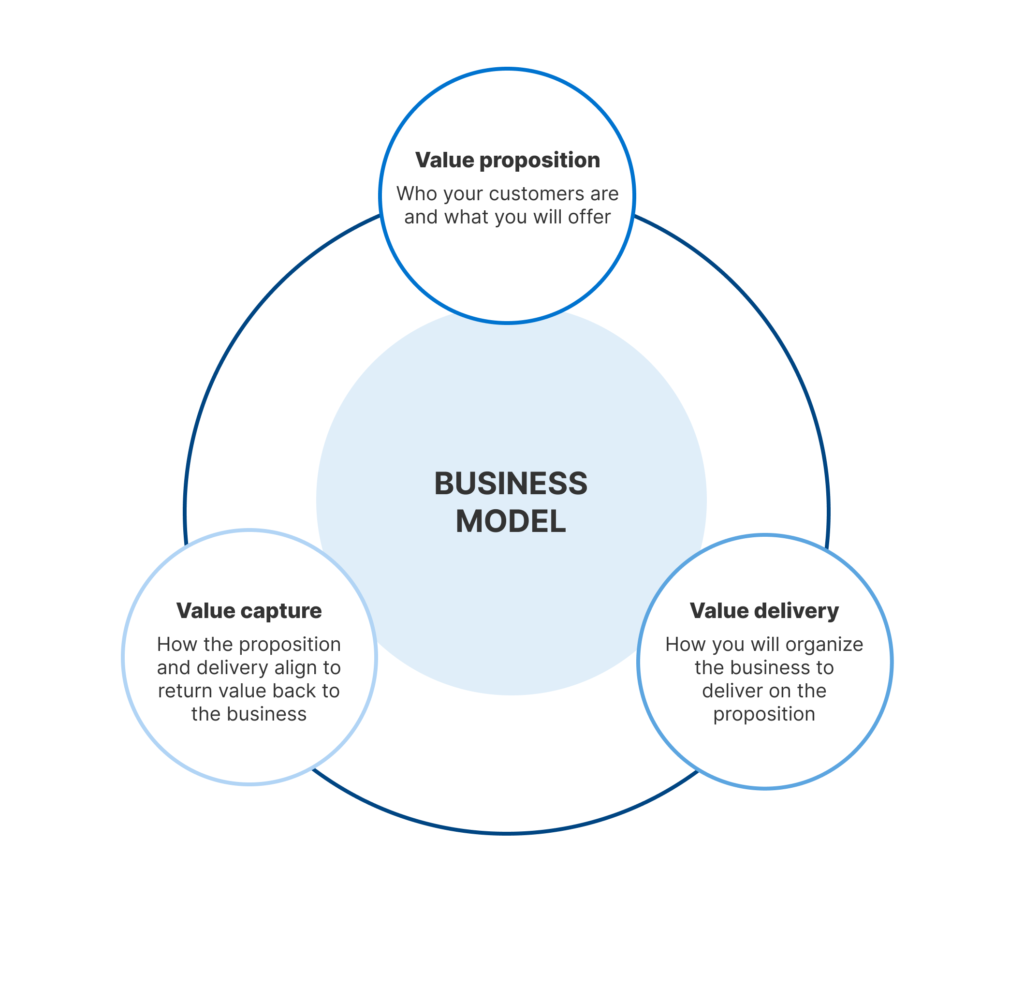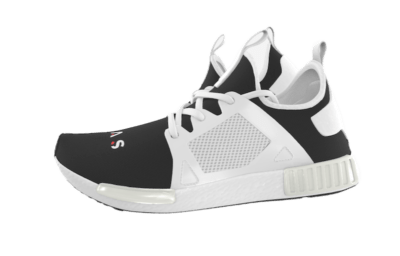Start by brainstorming and generating ideas for your product or service. Look for opportunities in the market, identify problems that need solving, or explore your passions and interests. Once you have a concept in mind, conduct market research. Analyze the demand for your product or service, identify your target audience, and assess the competition. Understand the market dynamics, trends, and customer preferences.
Business Model
A business model is a fundamental framework or strategy that defines how a company creates, delivers, and captures value. It outlines the core elements of how a business operates and generates revenue. Three key components of a business model are value proposition, value capture, and value delivery:
Value Proposition
This explains the unique kind of value that a business offers to its customers. It answers why a customer should choose your product or service instead of all the others in the market. A good value proposition will address what a target market needs and desires. It may include factors like product quality, price, convenience, innovation, customer service, or a combination thereof. It defines how a business differs from the rest of the competitors and how it manages to deliver on customer demands.
Value Delivery
Value delivery is how the business can provide its offerings to customers. It represents the whole range of supplies, from production or sourcing to distribution and customer service. Efficient value delivery ensures that customers get the value promised in the value proposition. This includes logistics, inventory management, quality control, and customer support.
Value Capture
Value capture represents how a business monetizes its customers’ value. It defines the revenue generation mechanisms and pricing strategies. This aspect of the business model addresses questions like how much customers are willing to pay for the offered value, whether through one-time purchases, subscription models, licensing fees, advertising revenue, or other revenue strategies. Value capture ensures that the business can sustain itself financially and generate profits.

A successful business model aligns these three components to create a sustainable and profitable venture. It ensures that the value promised to customers in the value proposition is efficiently delivered through the value delivery system, and the business captures an appropriate share of that value to remain viable.
To remain competitive and relevant, businesses must continually assess and adapt their business models in response to changes in the market, customer preferences, technology, and competitive pressures.
Positioning/ Differentiation
To find out what makes you different, first, you must understand exactly who needs your products or services and why. Then, to command a spot in that audience’s mind, you must identify how your company is uniquely qualified to meet their needs better than competitors. Work through five questions to get there:
- Who are you helping? This is your audience.
- What’s their problem? You can also think of this as your audience’s pain point.
- Where do they go for help? Does another solution exist for their problem? If so, how do competitors solve the problem?
- Why choose your solution? What benefits can the audience expect?
- How is your solution better? What makes your solution unique? This is also known as your unique selling point.
Revenue Model
E-commerce platforms use various revenue models to generate income. Each model has its own advantages and may be suitable for different types of businesses. Some of the most common revenue models include the sales model, transaction fee model, subscription model, affiliate model, freemium model, dropshipping, advertising, and commission. Determine how your business wants to make money online.
Once you know which products or services you want to offer, to which customers, and how you will make money, its time to create your brand.
Branding
What is a brand?
Let’s explore two core brand functions: Tangible and Intangible.
- Tangible Brand: The tangible brand is objective. Everyone sees it the same way. This includes the brand’s name, logo, and product or service.
- Intangible Brand: The intangible brand exists in minds and hearts. Unique individuals or groups perceive it differently. This includes the brand’s story, culture, and the emotions or ideas it evokes.
When we talk about brands, we mean both the intangible and tangible aspects. But there’s more to a brand than a logo and a story. A brand has a name and logo, represents sets of products or services, communicates with a voice, and has a distinct identity.
In short, a brand tells people who you are and what you stand for. It helps them determine if they’d like to do business with you, or with your competitors.
“A brand is the set of expectations, memories, stories and relationships that, taken together, account for a consumer’s decision to choose one product or service over another.”
Seth Godin
Elements of a Valuable Brand
The intangible elements are what connect people to a brand.
Start by looking inward. Explore these questions below to determine your brand’s four core elements:
- Define your mission. What is your purpose in the world?
- What’s your story? Why did you choose this mission?
- Identify your people. Whose problem do you solve? What do they need and why?
- Articulate your value. How are you uniquely qualified to solve that problem?
These questions aren’t just for fun—your answers define your brand.
The Role of Brand Storytelling
A brand story weaves together a coherent narrative explaining who you are, what you do, and why it matters. Industry professionals use the term to describe nearly any story that helps communicate your brand identity. What’s your mission? What makes you different? And how do you help customers?
With the rise of digital marketing and automation, the modern consumer is constantly bombarded by digital content and ads. But a compelling brand story can cut through the noise. Whether describing why you started your business or relating how your product transformed a customer’s life, a well-told brand story can:
- Engage. Customers can sniff out a traditional sales spiel or marketing advertisement a mile away. By contrast, people enjoy—and will pay attention to—a good story. Funny, entertaining, surprising, emotional, or informative stories boost audience engagement and help them remember your brand.
- Connect. Effective brand stories declare who you are and who you’re for, attracting and deepening connections with customers who align with your vision and values.
- Persuade. Studies show that listening to a story activates the same parts of the brain as experiencing the story events yourself—a phenomenon known as neural coupling. A compelling brand story can influence buyers’ perceptions and behavior just as tangibly.
How to Tell a Brand Story

Imagine that you’re a marketing professional for Amas Footwear, an athletic shoe company. Where do you start telling your brand story?
Your Origin Story
Your origin story shares the history of your company. Why and how did the founder build your business? This approach is ideal for companies with an interesting or unique backstory. Bonus points if the founder overcame surprising twists and setbacks along the way.
Example for Amas Footwear: Perhaps the founder was an engineer and marathon runner who struggled to find shoes that could withstand heavy wear and tear. So, they set out to create the perfect running shoe themselves. This story emphasizes the idea that this is a brand “for athletes, by athletes.”
A Customer Story
You can also tell the story of how customers use your product or service to overcome a problem or improve their lives. Focusing on someone your target market relates to can help them imagine what it’s like to use your product or service and achieve similar results. Note that customer stories can be real or dramatized. Real customer stories foster authenticity and trust. Dramatized stories can give you more flexibility for creative, playful, or humorous approaches.
Example for Amas Footwear: Perhaps you tell the story of a customer who set a personal wellness goal of hiking a new trail every week for a year. The story would cover this customer’s challenges, journey, and transformation with the shoes playing the role of “trusty sidekick” through rainy days or rugged terrain. In the end, the story could impart the Amas Footwear mission of helping people achieve their athletic goals no matter what they are.
Your Company’s Purpose or Problem
Your brand story can revolve around your company’s purpose or problem as well. What’s your vision or mission—and how do you achieve it? What problem do you solve for customers? Why are team members personally invested? Consider sharing behind-the-scenes stories from company leaders and employees.
Example for Amas Footwear: You could offer a 360-degree perspective of how Amas Footwear worked with a professional athlete to create a custom athletic shoe. What problems was the athlete facing? And how did your team tackle those problems to fit their needs?
Your Culture or Values
Finally, you can create a brand story that demonstrates your company’s values or culture in action. If you take this approach, support lofty declarations with specific examples of how you apply those values daily. Lifting the veil on your work teams, processes, and culture can create a sense of transparency that customers trust and crave.
Example for Amas Footwear: If you wanted to share Amas Footwear’s passion for innovation, you might give an “insider’s look” at your company’s shoe design and production process from beginning to end. This story would highlight how much research, thought, creativity, technology, and testing go into manufacturing a high-end performance shoe.
Visual Brand Design
Key Elements of Brand Design
Your logo is the symbol or mark that represents the company. It can include your company name, though a highly recognizable brand may use a symbol alone. Keep these tips in mind as you choose a logo:
- The logo should visually align with your mission and purpose.
- Keep it simple for flexibility as you grow, and to scale between mediums.
- Shape and color impact perception—choose carefully.
- Ensure your logo looks great in color, black, and white.
- If your logo stands out from the competition, make sure it’s on purpose.
Typography is the art of type or lettering—in this context, a brand’s fonts.
- Choose two or three complementary, but distinct fonts.
- Define how you’ll use the fonts. For example, choose one font for headers, and a second for body text.
- The most common font types are serif, sans, script, and display (or decorative). These types tend to connote different emotions or ideas.
Color is the third pillar of visual brand design. Color psychology is well documented, proving that color dramatically influences perception and emotion. Consider these tips for choosing color:
- Most brands stick with one to three primary colors for the core brand visual.
- A secondary palette offers options for texture, depth, background, and text.
- If your competition all use blue, a different color can help you stand out. But be careful that your unique choice still sends a brand-aligned message.
- Alternatively, try tints or shades of color for a unique take on a standard color.
Try the Canva color explainer to learn more about colors.
Black: sophisticated, power, status
Blue: loyalty, trust, calm, honesty
Red: passion, excitement, bold, energy
White: pure, innocent, clean, simple, elegant.
Green: harmony, growth, balance, safety
Violet: spiritual, depth, royal, prosperity
Yellow: inspiration, optimism, creativity, happiness.
Media assets can be photography, illustrations, icons, or videos.
- Photography should represent your audience and the way the brand should make them feel. Remember to be inclusive.
- Illustration style, much like color and type, should reflect the brand’s emotional tone. Playful, soft, or rugged—ensure it keeps the visual story intact.
- Icons are simple, visual representations that can underscore a product or concept. Despite their simplicity, their nuances are important. Icons should be from the same family—whether bold or thin, chunky or detailed, solid or shaded.
Universities tend to use bold primary colors. BU uses a bold red color, signifying strength, excitement and energy. BU’s official typeface is the Whitney font, a sans serif font developed originally for an art museum in New York. But the logo below uses the Scala font, developed by a Dutch designer.

On this website, you can find more about the BU brand guidelines: https://www.bu.edu/brand/
Useful tools:
Color Picker to select brand colors: https://htmlcolorcodes.com/color-picker/
Google Fonts to select fonts: https://fonts.google.com
Free image libraries: https://unsplash.com/, https://www.pexels.com/, https://pixabay.com, https://www.freeimages.com
Singapore Airlines, one of the most prolific brands in Asia.

Singapore Airlines has established itself as a global carrier, connecting passengers to major destinations across the world. With a strong focus on the premium travel segment, SIA caters to discerning travelers seeking luxury, comfort, and convenience. The airline’s branding strategy emphasizes its premium positioning and exclusive offerings, including the Singapore Suites, first-class cabins, and signature services like Book the Cook, which allows passengers to pre-select their inflight meals.
-Emphasis on Service Excellence: At the heart of Singapore Airlines’ brand is its unwavering focus on providing exceptional customer service. SIA positions itself as a premium airline that prioritizes passenger comfort and satisfaction. The airline’s brand promise revolves around the concept of “Service even other airlines talk about,” highlighting its commitment to going above and beyond to meet and exceed customer expectations.
-Iconic Singapore Girl: One of the most recognizable and enduring symbols of Singapore Airlines is the Singapore Girl. Since its introduction in 1972, the Singapore Girl has become an integral part of the airline’s brand identity. Representing elegance, grace, and warmth, the Singapore Girl embodies the attentive and personalized service that SIA is known for. This iconic figure has become synonymous with the airline’s brand and evokes a sense of trust and reliability among passengers.

The airline staff is dressed in premium uniforms designed by Balmain.
-Consistency and Attention to Detail: Singapore Airlines consistently delivers a high standard of service across all touchpoints, ensuring a consistent brand experience for passengers. From the moment customers interact with the airline’s website or book their tickets to their in-flight experience and beyond, every aspect of the journey is meticulously designed and executed. Attention to detail, whether in terms of cabin design, inflight meals, or staff training, is a hallmark of the SIA brand.
-Innovation and Technological Advancements: The airline continuously invests in cutting-edge technology and amenities, such as advanced in-flight entertainment systems, Wi-Fi connectivity, and state-of-the-art aircraft. This emphasis on innovation and embracing the latest advancements reinforces SIA’s brand image as a forward-thinking and modern airline.


Singapore Airlines opted for a blue and yellow/gold color scheme to represent their brand. Blue is the color of the sky, and yellow is the color of the sun. Both colors give the brand a modern, sophisticated look. On its website and in advertisements, the airline maintains the same elegant, refined style. The style is minimalistic yet luxurious, and communicates the premium positioning of the brand. Most of its imagery portrays stunning natural beauty, luxury, simplicity, sustainability, diversity, and a global outlook.
